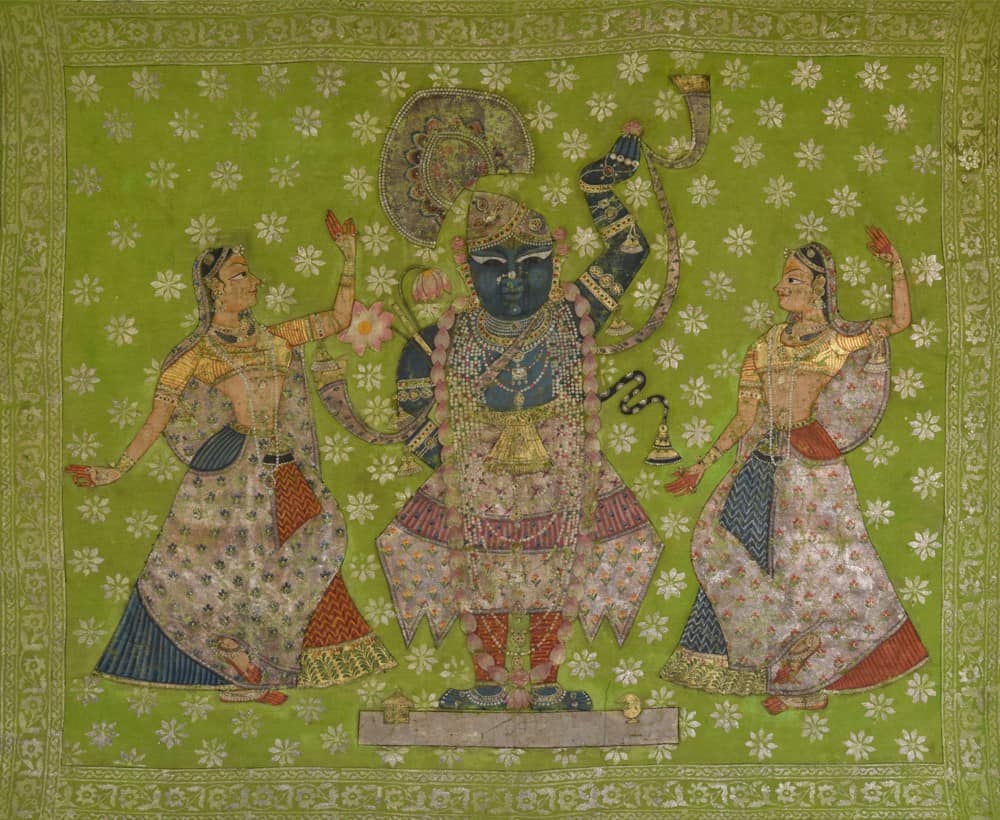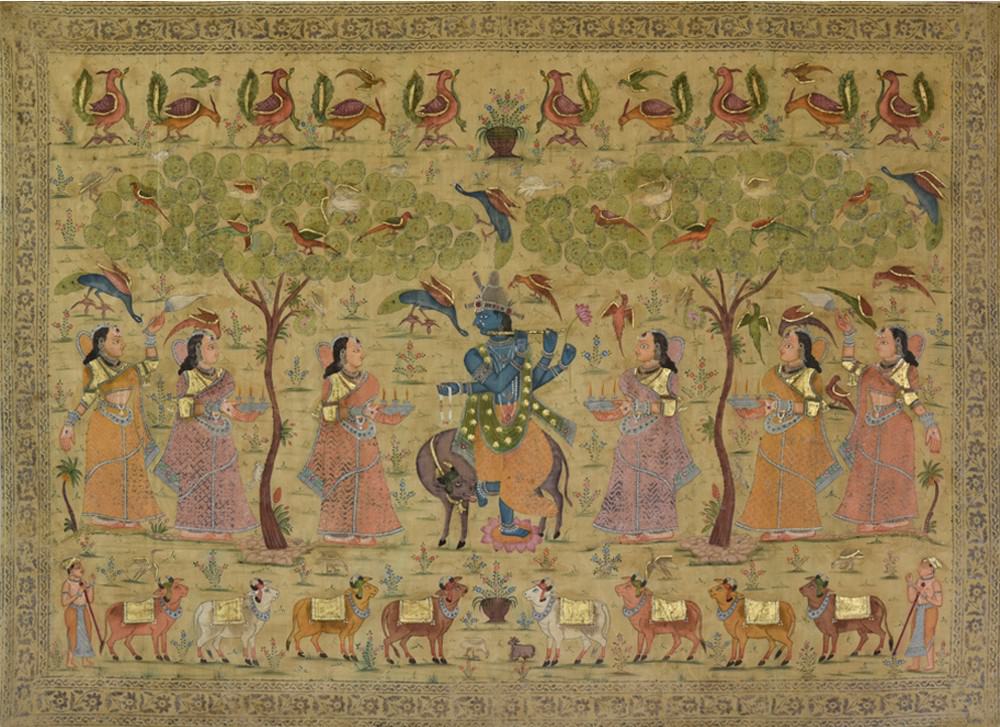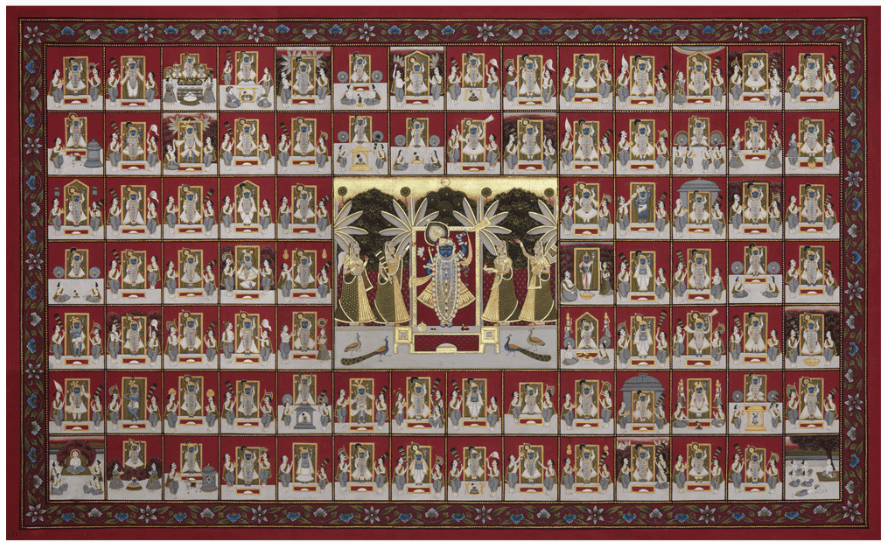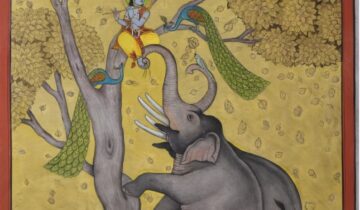5 Stages of Pichwai Art’s Dynamic Evolution: Temple to Artwork Journey
Introduction
Temples to Artwork Journey encapsulates the extraordinary ability of art to transcend time and space, bridging the gap between the divine and the tangible. Pichwai paintings, a traditional Indian art form, exemplify this phenomenon. In this captivating exploration of the “5 Powerful Stages: Pichwai Paintings Temple to Artwork Journey,” we embark on a remarkable odyssey that traces the evolution of these exquisite artworks from the sacred precincts of temples to the mesmerizing world of canvas.
Each stage in this journey is a testament to the devotion, skill, and passion of the artists who have meticulously preserved and transformed this age-old tradition. From the initial spark of inspiration that ignites the creative process to the intricate techniques employed in translating divine visions onto canvas, we uncover the secrets and artistry behind Pichwai paintings.
Stage 1: Spiritual Genesis of Pichwai Art
Pichwai art’s journey begins with its spiritual genesis on the walls of Hindu temples, particularly those dedicated to Lord Krishna. Originating in the sacred town of Nathdwara, Rajasthan, these intricate artworks were crafted as vibrant backdrops for deity shrines.
Each stroke of color and detail held profound symbolism, narrating tales from Lord Krishna’s life, accentuating his divine exploits and childhood stories. Serving as a visual gateway to connect devotees with their spiritual beliefs, this stage laid the foundation for the art form’s sacred identity, setting the tone for its subsequent evolution into a cherished cultural treasure.
Stage 2: The Craftsmanship Unveiled
At the heart of Pichwai art lies profound craftsmanship that breathes life into each stroke and hue. This pivotal stage unravels the meticulous artistry that transforms raw materials into mesmerizing masterpieces. Guided by tradition, skilled pichwaiwalas embark on a journey of creation, blending age-old techniques with unwavering dedication.
Every step is a testament to their expertise – from hand-preparing canvases to sourcing natural pigments extracted from minerals, plants, and even precious stones. The process weaves together colors that evoke emotion and narrative depth. The unveiled craftsmanship ensures that Pichwai art remains not just a visual delight, but a timeless homage to skill and devotion.
Stage 3: Transition from Temples to Homes
The evolution of Pichwai art entered a transformative phase as it journeyed from the sacred confines of temples to the intimate spaces of homes. No longer confined to religious shrines, Pichwai art found a new purpose as it adorned the walls of residences. This transition marked a shift in perception, as these intricate artworks transformed from being symbols of devotion to cherished elements of interior decor.
Collectors and art enthusiasts embraced Pichwai art for its vibrant colors and intricate storytelling, inviting the aura of tradition into their living spaces. The art’s ability to evoke a sense of cultural connection while harmonizing with modern aesthetics facilitated its integration into diverse home environments. This stage not only expanded Pichwai art’s reach but also highlighted its adaptability and enduring charm.
Stage 4: Pichwai Revival and Contemporary Adaptations
In the realm of art, evolution is often accompanied by revitalization, and Pichwai art is no exception. Stage 4 of Pichwai’s journey witnesses a remarkable revival, where traditional heritage meets modern innovation. As the world embraces nostalgia for cultural roots, Pichwai art experiences a resurgence of interest.
Contemporary artists are infusing their interpretations, breathing new life into this centuries-old art form. While staying loyal to the intricacies that define Pichwai, these adaptations introduce fresh elements – a fusion that resonates with both purists and new-age enthusiasts. Pichwai’s revival marks a pivotal point where past and present intertwine, ensuring its continued vibrancy on the global stage.
Stage 5: Global Recognition and Future Prospects
In the context of the Powerful Stages within the Temple to Artwork Journey of Pichwai art, Stage 5 stands as a pivotal chapter. It signifies a momentous turning point where this ancient art form’s timeless charm has transcended the confines of its origin and reached a global audience. This phase represents a remarkable milestone, as Pichwai art gains recognition on a truly international scale. Its intricate narratives and vibrant aesthetics have resonated deeply with art enthusiasts worldwide.
As Pichwai art finds its place in prestigious international exhibitions, galleries, and cultural exchanges, the Temple to Artwork Journey for this exquisite tradition appears exceptionally promising. This global recognition not only fosters cross-cultural understanding but also paves the way for innovative adaptations, ensuring Pichwai art’s enduring legacy for generations to come.
Conclusion: Pichwai Paintings – A Temple to Artwork Journey
In this exploration of the 5 Powerful Stages that constitute the Temple to Artwork Journey of Pichwai Paintings, we’ve delved deep into the intricate artistry that breathes life into this traditional Indian art form. From the initial spark of inspiration drawn from temple walls to the meticulous process of translating divine visions onto canvas, each stage unveils the dedication and craftsmanship that makes Pichwai truly remarkable.
These Powerful Stages represent not just a creative journey, but a spiritual one, as artists channel their devotion into every brushstroke. The careful selection of materials, the precision of sketching, and the labor-intensive painting process all culminate in a final masterpiece that encapsulates the essence of divine beauty.
Pichwai Paintings, in their Temple to Artwork Journey, serve as a bridge between the sacred and the artistic, carrying forward a rich cultural heritage. The meticulous attention to detail, the vibrant colors, and the stories they tell continue to captivate art enthusiasts around the world. This journey is a testament to the enduring legacy of Pichwai art, preserving its spiritual significance while embracing the canvas as a new medium for its timeless beauty.









 No products in the cart.
No products in the cart.